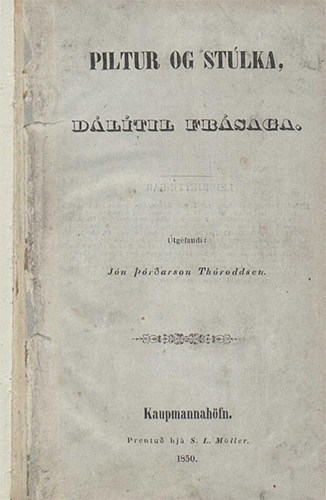16 Icelandic

Icelandic literature after the Reformation was primarily the domain of poetry until the mid-19th century. Following a small number of unpublished collections of short stories, folk tales, and several published prose translations into Icelandic in the 18th century, currents of European influence encouraged the sustained development of literary prose. At first short stories, they drew upon in some cases local saga and folkloric traditions. Credit for the first Icelandic novel is generally given to Jón Thóroddsen (1818-1868) for his 1850 work Piltur og Stúlka (Lad and Lass). As scholar and statesman Jón Sigurðsson would write in his introduction to a posthumous edition (1876) of Thóroddsen’s second, unfinished novel Maður og Kona (Man and Woman), “Various attempts have been made in our country before this to compose works of fiction similar to those which had appeared in foreign lands in modern times, which are called in English ‘novels,’ because they draw their material from modern everyday life, and not from ancient events or historical writings, as do the knightly romances; but this story of Thóroddsen’s [Piltur og Stúlka] is the most important of all these tales, and is hence universally conceded to be the first Icelandic novel [translation from Reeves’ 1890 edition of Lad and Lass].”
Born in western Iceland, Thóroddsen traveled to Copenhagen to study law, where he also pursued literary interests as co-creator and editor of a liberal arts annual to which he contributed his own poetry and several short texts (in addition to briefly joining the Danish army in its fight against rebellious Germans). During the winter of 1848-9 he wrote Piltur og Stúlka, which was published in Copenhagen in 1850 (a second edition was published in Reykjavik in 1867). Although indebted to the English romantic love story, this tale of the complicated love between Indriði and Sigríður, which begins and ends in the countryside and includes a journey to Reykjavik at its middle, is highly localized in its descriptions of contemporary Icelandic society. Thóroddsen was a keen observer of character, and his readers were especially drawn to the comic traits with which he endowed some of them. Other aspects of description as well as narrative reveal the influence of the Icelandic sagas. In 1850 Thóroddsen returned to Iceland, where he worked as a bailiff, and nearly completed his second novel before his death in 1868. Piltur og Stúlka has been published in a number of subsequent editions, translated into four languages, and was adapted for the stage in Iceland in 1933. The UC Berkeley Library owns the 1973 reprint of the 1948 edition, which was published in Reykjavik.
The Modern Icelandic language has been taught at the introductory level in UC Berkeley’s Scandinavian Department since 2015, when a pilot program was launched with the assistance of the Institute of European Studies.
Contribution by Jeremy Ott
Classics and Germanic Studies Librarian, Doe Library
Title in English: Lad and Lass
Author: Jón Thóroddsen, 1818-1868.
Imprint: Kaupmannahöfn : S.L. Möller, 1850.
Edition: 1st
Language: Icelandic
Language Family: Indo-European, Germanic
Source: The Internet Archive (National and University Library of Iceland)
URL: https://archive.org/details/Pilturogstulkada000209560v0JonReyk
Other online editions:
- Sigrid: An Icelandic Love Story. Translated from the Danish by C. Chrest. New York: T.Y. Crowell & Co, 1887 in HathiTrust Digital Library.
Select Print editions at Berkeley:
Piltur og stúlka: dálítil frásaga. Reykjavík: Helgafell, 1973. Reprint of the 1948 edition.

